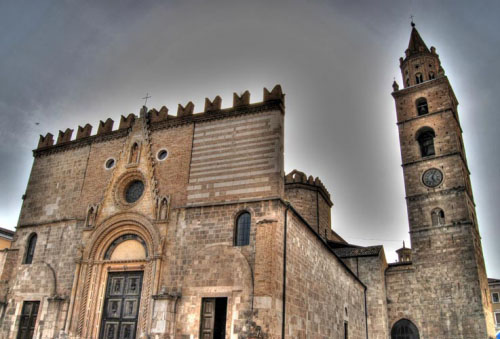Under the dominion of Rome (Pretut was conquered in 268 BC), in particular under the emperors Augustus and Elio Adriano originally from nearby Atri, Interamnia experienced a long golden age which was witnessed by the temples, the baths, the theater and the amphitheater and all a series of monuments now submerged by the new city and became, at the same time, town hall and colony.
After the fall of the Roman Empire it was destroyed at the beginning of the 400s by the Goths and Visigoths. Following the conquest of the Lombards, the city, first renamed Aprimium and subsequently Teramum, was annexed to the Duchy of Spoleto.
Before the unification of Italy Teramo experienced further ups and downs in history under the dominion of the Normans, the Signoria of the Acquaviva, the bishop’s domination, the Kingdom of Naples to then follow the fate of the rest of the South. The main monuments to see are located in the historic centre, starting with the Roman Theater built in 30 BC. whose finds give the idea of its considerable original size which would have allowed the entry of over three thousand spectators.
Next to it stood the Amphitheater, whose construction dates back to the first century AD. Valuable then, the Mosaic of the Lion, datable to the 1st century BC. located in the homonymous domus near the ancient forum of the city, it is one of the most beautiful works of art of the Roman period present in Teramo similar in workmanship to other mosaics found in Hadrian’s villa in Tivoli and Pompeii.
But the symbol of Teramo is its Duomo or Cathedral of San Berardo, built starting from 1158 and recently restored, which is located in the beautiful Piazza Martiri and has a predominantly Romanesque style, while presenting numerous Gothic elements.

THE IMPRESSIVE FAÇADE IS EMBELLISHED BY THE ROMAN DIODATO PORTAL (1332) AND A SOLEMN ROSE WINDOW,
while the interior with three naves preserves a magnificent medieval altar with the sculpture in embossed and enamelled silver of the Paliotto (1443-1448) by Nicola da Guardiagrele and representing scenes from the life of Jesus. The Polyptych of Sant’Agostino (15th century) , by the Venetian Jacobello del Fiore, is one of the best examples of Renaissance painting in Abruzzo.
On the other hand, the ancient cathedral, today Sant’Anna, dates back to the Byzantine age, built on the ruins of an ancient Roman domus. Inside, under glass slabs, you can admire a panoramic mosaic floor, while behind the altar there are important 14th-15th century frescoes with the image of the Madonna in the centre.
Not far away, the Church of Sant’Antonio from 1227 and the Romanesque San Domenico, with the remains of medieval frescoes also present in the narrow but fascinating cloister.
Worth noting are the Convent of San Giovanni with the restored cloister and the church of the Madonna delle Grazie (1153) once a monastery of Benedictine nuns. In the historic center there are also the fourteenth-century structures of the Bishop’s Palace and the Loggia del Municipio.
The Astronomical Observatory of Collurania is located on a hill a few kilometers from the city. It is possible to reach the city of Teramo along the S.S. 80 which connects Giulianova with Teramo.

